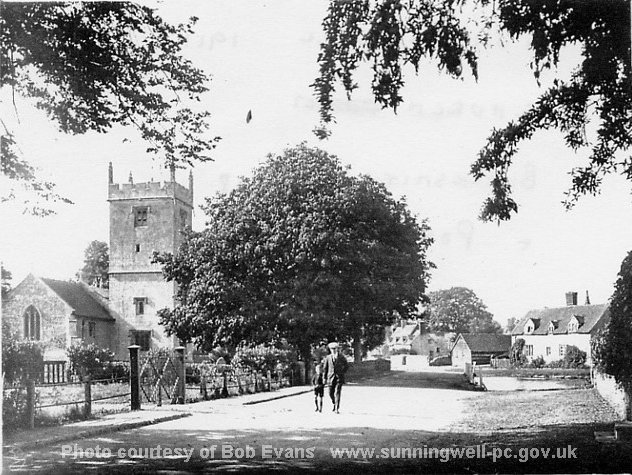By village resident Bob Evans – former Regius Professor of History at Oxford
Sunningwell village is an ancient settlement in a fold of the slopes which lead down from Boars Hill towards Abingdon. The name, along with that of its sister community, seems to be first recorded in the year 821 as ‘Sonnyngwella cum Baiwurda [Bayworth]’. It appears in a charter which may well have been forged at a later date by the monks of Abingdon, but whose details needed to be close enough to the truth to be persuasive.
The ‘well’ is the pond still to be seen at the centre of the village: it is fed by an underground spring warm enough to prevent it from ever freezing. ‘Sunning’, i.e. the ‘ing’ of Sunna, preserves the memory of an early Saxon chieftain and his clan. Bayworth was founded as the enclosure (the ‘worth’ – an expression, like ‘ing’, from the earliest days of English settlement) of a still obscurer individual called Baega. We know nothing more about these 9th-century people, nor about any of their predecessors, though the remains of brick kilns on the hillside above the village testify that the Romans valued this area.
Legend has it that Sunningwell formed the original site of the monastery which was then relocated beside the river at Abingdon. At all events the village became part of the extensive lands of the town’s Benedictine abbey throughout the Middle Ages, albeit for some reason the monks never took over its greater tithes, i.e. the tenth part of cereal crops grown in the parish, but left them in the hands of the local incumbent. For that reason Sunningwell’s clergymen (and now -women) are to this day described as ‘rectors’ rather than ‘vicars’.
The only clear survival from that period is the fabric of the church (see separate article). The village contains a number of other old buildings, notably two farms now converted into private accommodation: Church Farm almost opposite the church and Beaulieu Court Farm at the top of the rise behind it, beyond the entry onto the Green from the south east. The 19th-century Rectory is likewise no longer used for its original purpose, since the benefice was united with Radley during the 1980s, and then also with Kennington. Beyond it, however, what began as a mock-Elizabethan private dwelling is nowadays the ‘Flowing Well’ public house.
Further in the direction of Bayworth stand Sunningwell House, with an attractive 18th-century facade, and across from it Sunningwell Manor, with a late medieval jetty, or projecting upper storey, perhaps once a hospice or grange of the Abingdon monks. The Manor (as it’s called, though it never functioned as such) was the home of a prominent campaigner for women’s rights, Una Dugdale, who had married her husband and fellow-crusader, Victor Duval, at a ‘suffragette’ wedding (without promise of obedience, etc.) in 1913. The Victorian school building behind the pond abuts an older cottage, and it was there, or in a house close by, that the painter J M W Turner used as a young man to come from London to stay with his uncle and aunt, Joseph and Mary Marshall. We can imagine him walking the path from here to Oxford over Boars Hill and sketching drafts along the way for some of his celebrated views of the city.
For centuries after the dissolution of Abingdon Abbey under Henry VIII, most of Sunningwell belonged to a large estate. Early owners were the Baskervilles, who lived in style at Bayworth until profligate and eccentric living took their toll. Once the manor house disappeared, the lords of the manor were non-resident. In the 18th and 19th centuries the families of Ston(e)house and then Bowyer added Sunningwell to their holdings at Radley. Then the estate passed to the Disneys of Ingatestone in Essex, who sold up in 1912, at which time many of its thirty-eight cottages passed into private ownership. Most must subsequently have been demolished and replaced, since the bulk of the village’s current housing stock is modern.
Other major changes took place around that date. Ample properties began to spread on Boars Hill, part of which lies in Sunningwell parish, and more modest ones at Whitecross on the way to Wootton. There was expansion also of the neighbouring settlement of Bayworth, around its pleasing little chapel built in 1900. As the 20th century proceeded, many of the traditions of the historic agrarian community were lost for ever. Nevertheless, Sunningwell itself remains a small and largely unspoiled village, with many local activities.
The Old School, which closed in the 1970s, is now a thriving regional centre for the arts; while a new school on the edge of the village likewise flourishes, with about a hundred children from Sunningwell and its vicinity currently on the roll. The Village Hall was built in 1906 and expanded a century ago as a memorial to local soldiers of the Great War; it is widely used for meetings and social events. Our oldest communal institution must be the charity for the poor, first mentioned in the reign of Edward III; but in modern times the Cricket Club, which plays on a pretty recreation ground to the Wootton side of the village, can boast a continuous history back well into the nineteenth century.

